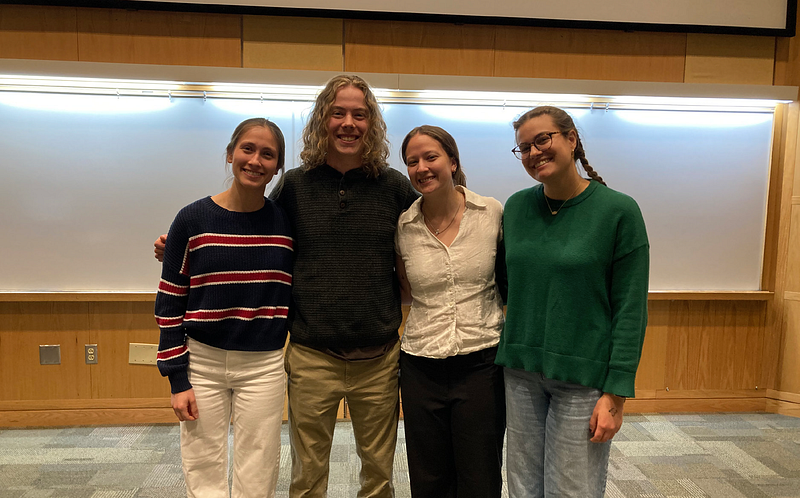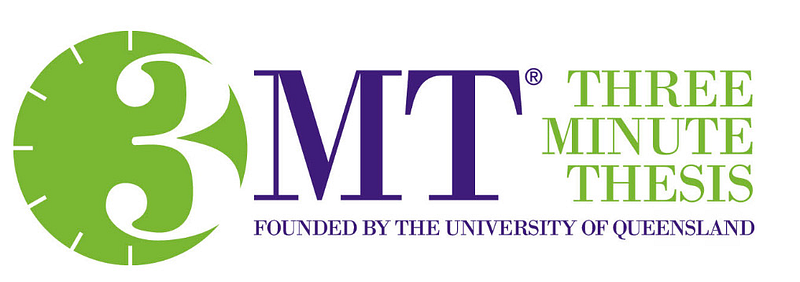
The 2024 Three Minute Thesis Competition was held on Saturday, April 27 in the Bradford Auditorium, where seniors were tasked with the challenge of summarizing their thesis to an audience in just three minutes. This competition was open to all members of the senior class and had nineteen entries from seventeen different students, covering fifteen different concentrations. Community members from Clinton and Utica formed the judging panel to ensure that students make their presentations accessible to a general audience and not just people within the individual disciplines. The judges considered students’ engagement with the audience and how well the slides supported what they were talking about.
Participants of the competition were eligible for cash prizes. The first place prize was $1000, second place prize was $750, third place prize was $500, and People’s Choice prize was $250. The People’s Choice Award went to the speech with the most in-person audience votes. The Three Minute Thesis competition is organized by the Oral Communication Center, with financial support from the Leonard C. Ferguson Endowment.
The Three Minute Thesis competition was developed by The University of Queensland. According to their website, “the Three Minute Thesis competition celebrates the exciting research conducted by Doctor of Philosophy students. Developed by The University of Queensland, 3MT cultivates students’ academic, presentation, and research communication skills. The competition supports their capacity to effectively explain their research in three minutes, in a language appropriate to a non-specialist audience.”
Julien Swoap ’24 won the first place prize for his neuroscience thesis titled “Investigating the Impact of Intrusive Thoughts on Selective Attention.” Swoap opened his presentation presenting the statistic that on average, people have over 6,200 thoughts per day. “You might be familiar with the thought while driving: Oh, what if I just turned and crashed my car?” he said. “Now, while alarming, we do have a name for this. This is an intrusive thought and intrusive thoughts come and go for people all across the world.”
Swoap explained that for individuals with Obsessive Compulsive Disorder (OCD), intrusive thoughts are more significant to their daily experience. Individuals with OCD have worse selective attention, which is the ability to attend to relevant information while ignoring irrelevant information. Intrusive thoughts present themselves as irrelevant information that take away their attention from relevant information. The research question that inspired Swoap’s research is how OCD relates to selective attention and intrusive thoughts. He hypothesized that individuals in the intrusive thought group had worse selective attention, as these intrusive thoughts would pull their attention away from the task at hand.
He took 62 Hamilton students and randomly assigned them to an experimental group or a control group. They were told to visualize a personally relevant intrusive thought, such as thinking about a family member being harmed in some way. The control group was told to visualize a neutral scene, such as a common storefront that they were familiar with. The participants of the experiment completed a computerized visual search task that measures selective attention.
Swoap actually found that the control group exhibited worse selective attention. He hypothesizes that this is due to the effect of stress, which is known to be associated with intrusive thoughts and can improve performance. He believes that those with the intrusive thoughts were stressed during the test, which allowed them to focus more and perform better.
Swoap concluded that there is a need for more research “to better understand the mechanisms of how individuals experience intrusive thoughts and…better understand how these individuals navigate day-to-day functioning, such as the very important task of selective attention which allows us to navigate and interact with the world in beneficial ways.”
Hannah Jablons ’24 won the second place prize for their history thesis titled “Dan’s Manhattan Plaza,” focusing on Manhattan Plaza, a residential Manhattan building that created a space for those in the performing arts space. Manhattan Plaza, initially was meant to be used as middle-income subsidized housing, but due to the city’s precarious economic condition, this was not possible. As Jablons shares, “the reason that Manhattan Plaza failed as middle-income subsidized housing is parallel to the reason that the city almost went bankrupt.” The project’s survival depended on the collaboration and support of both private and public groups to make Manhattan Plaza Section 8 housing, which allows for residents to pay a component of their salary towards rent on a sliding scale.
Dan Rose was responsible for filling the building with residents, and through an original interview with Jablons, was able to be officially credited with the idea of making the space a dedicated space for performing artists, working under the mantra that “artists were broke, but not poor, which evaded stereotypes about the typical Section 8 resident.”
They conclude their summary with a key point of their thesis: “when you give people housing, you give them the stability and the freedom to take risks in their career, and when you give all that to artists, you make a miracle.”
Aliana Potter ’24, who won the third place prize for her thesis titled “Primary Care Provider Practice Patterns in Health Provider Shortage Areas and non-HPSAs” has an interdisciplinary concentration in Public Health.
Through interviewing 15 different primary care providers, half in Utica and half in the Boston area, Potter aimed to understand the impact of the Healthcare Provider Shortage Areas (HSPAs) — an area with less than one provider per 3,500 residents — in the Utica Area.
Many providers highlighted rates of malpractice and burnout from the COVID-19 pandemic. However, some Boston interviewees highlighted something surprising for the area: “the Healthcare Provider Shortage Area is not accurately reflecting the reality.” In conclusion, Potter deduced that there needs to be further research into the shortage struggle nationally and there is a great need to solve burnout and administrative burden issues in the healthcare space to better support physicians as a whole.
The People’s Choice Award was won by Bobbi Roca ’24 for her biology thesis titled “Climate Change and Trees: Which ones are built different.” Roca told the audience that climate change can manifest itself in places like upstate New York as early warming temperatures followed by cold temperatures. “For us this isn’t really harmful,” Roca said. “But for trees this is actually really dangerous because at the end of tree branches there are buds that will eventually bloom to become either leaves or flowers or roots.” Roca explained that when winter temperatures return after an “early spring,” the leaves, flowers, and fruits can die because they are not able to withstand these really cold temperatures. During this warming period, the snow on the ground melts, exposing the soil to cold temperatures, which allows the roots below the soil to get damaged. The roots are unable to send an adequate amount of nutrients to the leaves above.
The question that directed Roca’s research was: “How do tree seeds, these tiny little beings without this large energy reserve, respond to fall springs, followed by really cold temperatures?” Roca replicated an early spring followed by cold temperatures through a series of temperature chambers and found that the effect of this phenomenon depends on the species. Roca discovered that White Pine trees were “really good at not getting tricked into germination early by fall springs and also surviving really cold temperatures.” Roca concluded her thesis presentation by recommending to the audience that they consider planting white pines in their backyard, as these trees are the species that are best equipped to survive the consequences of climate change.
When the presentations concluded, index cards were handed out to all audience members except for the judges for voting on the People’s Choice Award. The audience members each wrote down a name and put their card into a ballot box. The judges reported a particularly close year, as there were only one to two point differences in the scores of the majority of the presentations. Videos of the presentations are available on the Hamilton College YouTube.

















